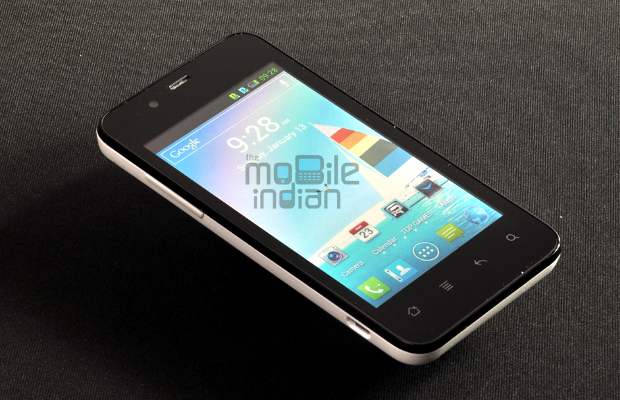Videocon has re-entered the Android smartphone market with two new phones called the A30 and the A20. The Dual SIM, Android 4.0 based A30 is currently the flagship phone of Videocon. It comes with 4 inch screen with WVGA (800 x 480 pixels) resolution and a 1 GHz dual core Qualcomm Scorpion processor.
It also has a 5 megapixel rear camera with LED flash and a front facing VGA camera. A 1500 mAh battery powers the phone which is priced at Rs 7,700.
Design
Videocon A30 has nothing special in terms of design. It has an all black front and a white coloured back panel which is shiny and can get slippery. The camera sits in the top middle portion flanked by an LED flash. The Videocon logo is at the bottom, slightly above the speaker grill.
The power button is situated on the top towards the left side instead of the usual right hand top side. Since the phone is small in size, the placement is not an issue, but the 3.5 mm jack is placed on the right of the power/lock button, which makes it a bit awkward to unlock the phone while using the headphone. However it is not a deal breaker anyways.
The volume rocker is on the top left side while the USB slot is on the lower side of it. Inside the back panel, the Videocon A30 houses two SIM slots alongside the micro SD card slot. Thankfully, one need not to remove the battery to access these but a hot swappable memory slot (which does not require the phone to be shut down while inserting or removing the SD card) would have been better.
The four capacitive touch buttons below the screen are all back lit. Having four buttons point to the fact that phone was designed for Android 2.3 but Android 4.0 was ported to it. This though is no drawback as it allows all the functions Android 4.0 except for that fact that you will have to long press the home button to see all the running apps which in case of three button design is a one touch affair.
Display
Videocon A30 has a multi-touch four inch display with 800×480 pixel resolution. This is a standard set of resolution that you get with most budget 7 inch tablets and 5 inch phones. Since it has a smaller screen the Pixel density looks good; colour reproduction and sharpness are fine as well.
Though not an IPS panel, the display of Videocon A30 offers decent viewing angles. The screen is quite bright too which aids visibility in brighter environments and even in bright sunlight you can operate the phone without much difficulty.
The touch sensitivity is slightly lower than many other phones, but it’s just a bit lower and nothing much to complain. It is only while playing games that you will realise its slow response.
Performance
The phone is based on Qualcomm dual core Scorpion processor, clocked at 1 GHz and is coupled with 512 MB RAM and Adreno 220 graphics processor. The combination is expected to offer decent performance. During our short interaction, the handset performed well but we will give a final word on the same once we do all out tests.
Videocon A30 offers about 1 GB of internal storage which should give enough space for downloaded applications, which perform better on flash memory (internal memory) than when placed on external memory.
Camera
The phone comes with a 5 megapixel camera at the back, which clicked some decent shots during our initial tests. The front camera is also decent for video chats.
Battery
Videocon A30 has a 1500 mAH battery which is quite common to smartphones in this price bracket. We have not tested it yet, but we don’t expect more than a day’s battery back up with this phone.
Competition
The phone competes directly with Karbonn A11 and Lava Iris N400. While Iris is priced slightly cheaper than A30, it lacks on Internal Memory (just 150 MB), while Karbonn A11 has 2 GB internal storage but is slightly more expensive (Rs 200 more).
Conclusion
A company like Videocon should have brought a differentiated product to the market to get back in the Android space. 
Having said that there is nothing lacking in A30 and the handset competes well with its immediate competition, but at the same time doesn’t offer anything special to the consumer that Videocon should have offered on its comeback device.


